| Article ID | Journal | Published Year | Pages | File Type |
|---|---|---|---|---|
| 4400305 | Limnologica - Ecology and Management of Inland Waters | 2016 | 6 Pages |
Due to the increasing number of biological invasions, more and more non-native species become components of already existing food chains and new interactions develop within communities. In our study, we checked whether (1) the predation preferences depended on sympatric or allopatric occurrence of predator and prey (a predator may choose the well-known prey or rather benefit from the naïvety of the novel one) and (2) fish preferences depended on prey susceptibility to fish predation (ability to hide, active predator avoidance) and/or on its palatability. We studied foraging efficiency of two species of Ponto-Caspian gobies (the round goby Neogobius melanostomus and tubenose goby Proterorhinus semilunaris) and the European bullhead Cottus gobio on two species of amphipods—Ponto-Caspian Dikerogammarus villosus and non-invasive Gammarus fossarum, occurring in Central and Western Europe. The gammarids were offered to fish with or without shelters and as mobile individuals or immobilized to test the effect of their hiding ability, mobility and palatability on fish predation. Fish selectivity was exhibited only in trials with motile prey, where all tested predators preferred G. fossarum over D. villosus, showing that their selectivity was independent of prey origin. No selectivity was observed for immobilized amphipods. When shelters were present, the predation was lowest. Thus, predator preferences depended on prey behavioural traits (effective shelter utilization and/or activity reduction) rather than on their palatability. Effective predator preference of G. fossarum over D. villosus may be one of the reasons of the successful invasion of the latter to the European inland waters.
